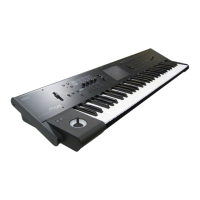PROG P0: Play 0–8: Control Surface
11
Default Tone Adjust Settings
You can use the Tone Adjust function to edit all of the
important program parameters on this single page. Most of
the preset sounds use the default layout shown below. You
can customize these default settings for each program.
For details on the Tone Adjust function, please see “0–7b:
Selected parameter information” on page 7.
Tone Adjust parameters
This applies to common tone adjust parameters and tone
adjust parameters following the “0–7b: Selected parameter
information” on page 7.
Default Tone Adjust Settings
▼0–7: Menu Command
• 0: Write Program ☞p.73
• 1: Exclusive Solo ☞p.73
• 2: Copy Tone Adjust ☞p.74
• 3: Reset Tone Adjust ☞p.74
For more information, please see “Program: Menu
Command” on page 73.
0–8: Control Surface
The control surface consists of the four knobs located in the
left side of the front panel and the four switches to their left.
You can use this control surface in a variety of ways, such as
editing the sound or effects, controlling the arpeggiator, or
transmitting MIDI messages to external devices.
This page shows you the current values for each of the
knobs, along with information about what they are
controlling. For instance, you can:
• Use the knobs to modulate sounds and effects
• Use the knobs to transmit MIDI messages to external
MIDI devices
• Use the knobs to control the arpeggiator
CONTROL ASSIGN switches and parameters
You can use Control Assign in the display or the front panel
REALTIME CONTROL, EXTERNAL, ARP switches to
switch the function of control surface. Because the display
and the front panel switches are linked, changing one will
change the other correspondingly.
In Program mode, you can select one of three different
functions:
Realtime Control: Use the knobs to control the sound or
effects.
External lets you send MIDI messages to external MIDI
devices. Use the Global P1: MIDI– External Mode 1/2 page
to select the MIDI message you wish to transmit.
ARP: Use the knobs to control the Arpeggiator function.
You can freely change back and forth between the different
functions, without losing any of your edits.
Reset controls
The front panel RESET CONTROLS switch lets you restore
the desired knobs of the control surface to the stored values.
You can also use this to reset the Arpeggiator settings. For
more information, please see “Resetting the controller
settings” on page 21 of the Owner’s manual.
Resetting a single control
To reset a single knob:
1. Hold down the RESET CONTROLS switch.
2. While holding down RESET CONTROLS, move a
knob or press one of the control surface switches.
The knob will be reset to the value stored in the Program.
3. When you’re done, release the RESET CONTROLS
switch.
Resetting a group of controls
1. Use the display’s Control Assign or the front panel
CONTROL ASSIGN switches to access the controllers
you want to reset.
Note: As a safety precaution, you can only reset the
parameters currently displayed on the Control Surface.
2. Hold down the RESET CONTROLS switch.
Controller Default settings
SW1 [OSC1] Transpose
SW2 [OSC2] Transpose
SW3 [OSC1] Tune
SW4 [OSC2] Tune
SW5 [OSC1]MS/DKit Select
SW6 Filter Cutoff
SW7 Filter Resonance
SW8 Filter EG Intensity
Slider1 [OSC1&2] Pitch Stretch
Slider2 [OSC1] Filter LFO1 Int A
Slider3 [OSC1] Amp LFO Int
Slider4 [OSC1] Drive
Slider5 F/A EG Attack Time
Slider6 F/A EG Decay Time
Slider7 F/A EG Sustain Level
Slider8 F/A EG Release Time

